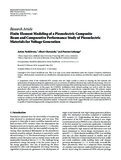Finite element modeling of a piezoelectric composite beam and comparative performance study of piezoelectric materials for voltage generation

View/
Date
2012Author
Nechibvute, A.
Chawanda, A.
Luhanga, P.
Publisher
International Scholarly Research Network, http://www.hindawi.com/isrn/materials.science/Type
Published ArticleMetadata
Show full item recordAbstract
A comparative study of the traditional PZT ceramics and new single crystals is critical in selecting the best material and
optimization of transducer design for applications such as conversion of ambient vibrations into useful electrical energy. However,
due tomaterial and fabrication costs and the need for rapid prototyping while optimizing transducer design, primary comparisons
can be based on simulation. In this paper, the COMSOL Multiphysics finite element package was used to study the direct piezoelectric effect when an external load is applied at the free end of a piezoelectric composite beam. The primary output
parameters such as electric potential and electric field were studied as a function of the input strain and stress. The modeling
is presented for the relatively new single crystal lead magnesium niobate-lead titanate (PMN32) and three different lead zirconate
titanate ceramics (PZT-5A, PZT-5H, and PZT-4). Material performance was assessed by using a common geometry and identical
excitation conditions for the different piezoelectric materials. For each material, there are three analyses performed, namely, static,
eigenfrequency, and transient/time-dependent analysis. Comparative results clearly suggest that the new crystal material PMN32 is capable of outperforming presently useing piezoelectric ceramics for voltage generation.
